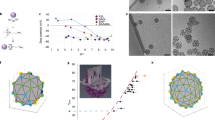Abstract
Ordering particles at the nanometre length scale is a challenging and active research area in materials science. Several approaches have so far been developed, ranging from the manipulation of individual particles1,2 to the exploitation of self-assembly in colloids3. Nanometre-scale ordering is well known to appear spontaneously when anisotropic organic moieties form liquid-crystalline phases; this behaviour is also observed for anisotropic mineral nanoparticles4,5 resulting in the formation of nematic4,5,6,7, smectic8 and hexagonal9,10 mesophases. Here we describe a lyotropic liquid-crystalline lamellar phase comprising an aqueous dispersion of planar solid-like sheets in which all the atoms involved in a layer are covalently bonded. The spacing of these phosphatoantimonate single layers can be increased 100-fold, resulting in one-dimensional structures whose periodicity can be tuned from 1.5 to 225 nanometres. These highly organized materials can be mechanically or magnetically aligned over large pH and temperature ranges, and this property can be used to measure residual dipolar couplings for the structure determination of biomolecules by liquid-state NMR. We also expect that our approach will result in the discovery of other classes of mineral lyotropic lamellar phases.
This is a preview of subscription content, access via your institution
Access options
Subscribe to this journal
Receive 51 print issues and online access
$199.00 per year
only $3.90 per issue
Buy this article
- Purchase on Springer Link
- Instant access to full article PDF
Prices may be subject to local taxes which are calculated during checkout






Similar content being viewed by others
References
Eigler, D. M. & Schweizer, E. K. Positioning single atoms with a scanning tunneling microscope. Nature 344, 524–526 (1990).
Poncharal, P., Wang, Z L., Ugarte, D. & de Heer, W. A. Electrostatic deflections and electromechanical resonances of carbon nanotubes. Science 283, 1513–1516 (1999).
Blanco, A. et al. Large-scale synthesis of a silicon photonic crystal with a complete three-dimensional bandgap near 1.5 micrometres. Nature 405, 437–440 (2000).
Davidson, P., Gabriel, J.-C., Levelut, A.-M. & Batail, P. Nematic liquid crystalline mineral polymers. Adv. Mater. 5, 665–668 (1993).
Gabriel, J.-C. P. & Davidson, P. New trends in colloidal liquid crystals based on mineral moieties. Adv. Mater. 12, 9–20 (2000).
Kajiwara, K., Donkai, N., Hiragi, Y. & Inagaki, H. Lyotropic mesophase of imogolite 1. Effect of polydispersity on phase diagram. Makromol. Chem. 187, 2883–2894 (1986).
Nikoobakht, B., Wang, Z. L. & El-Sayed, M. A. Self-assembly of gold nanorods. J. Phys. Chem. B 104, 1346–1348 (2000).
Maeda, Y. & Hachisu, S. Schiller layers in beta-ferric oxyhydroxide sol as an order–disorder phase separating system. Coll. Surf. 6, 1–16 (1983).
Brown, A. B. D., Ferrero, C., Narayanan, T. & Rennie, A. R. Phase separation and structure in a concentrated colloidal dispersion of uniform plates. Eur. Phys. J. B 11, 481–489 (1999).
van der Kooij, F. M., Kassapidou, K. & Lekkerkerker, H. N. W. Liquid crystal phase transitions in suspensions of polydisperse plate-like particles. Nature 406, 868–871 (2000).
Fraden, S. in Observation, Prediction, and Simulation of Phase Transitions in Complex Fluids (eds Baus, M., Rull, L. F. & Ryckaert, J. P.) 113–164 (NATO ASI Series, Kluwer Academic, Dordrecht, 1995).
Whittingham, M. W. & Jacobson, A. J. Intercalation Chemistry (Academic, New York, 1982).
Gabriel, J.-C. P., Sanchez, C. & Davidson, P. Observation of nematic liquid-crystal textures in aqueous gels of smectite clays. J. Phys. Chem. 100, 11139–11143 (1996).
Mourchid, A., Lécolier, E., Van Damme, H. & Levitz, P. On viscoelastic, birefringent, and swelling properties of laponite clay suspensions: revisited phase diagram. Langmuir 14, 4718–4723 (1998).
Piffard, Y., Verbaere, A., Lachgar, A., Deniard-Courant, S. & Tournoux, M. The layered phosphatoantimonic acid H3Sb3P2O14, x H2O. Rev. Chim. Miner. 23, 766–775 (1986).
Boesecke, P., Diat, O. & Rasmussen, B. High-brilliance beamline at the European Synchrotron Radiation Facility. Rev. Sci. Instrum. 66, 1636–1638 (1995).
Safinya, C. R. et al. Steric interaction in a model multimembrane system: a synchrotron study. Phys. Rev. Lett. 57, 2718–2721 (1986).
Salditt, T. et al. Specular and diffuse scattering of highly aligned phospholipid membranes. Phys. Rev. E 60, 7285–7289 (1999).
Deryagin, B. V. & Landau, L. Theory of the stability of strongly charged lyophobic sols and of the adhesion of strongly charged particles in solutions of electrolytes. Acta Physicochim. URSS 14, 633–662 (1941).
Verwey, E. J. W. & Overbeek, J. Th. G. Theory of the Stability of Lyophobic Colloids (Elsevier, Amsterdam, 1948).
Safinya, C. R. et al. Structure of membrane surfactant and liquid-crystalline smectic lamellar phases under flow. Science 261, 588–591 (1993).
Tjandra, N. & Bax, A. Direct measurement of distances and angles in biomolecules by NMR in a dilute liquid crystalline medium. Science 278, 1111–1114 (1997).
Desvaux, H., Gabriel, J.-C. P., Berthault, P. & Camerel, F. First use of a mineral liquid crystal for NMR measurement of residual dipolar couplings of a non-labeled biomolecule. Angew. Chem. 40, 373–376 (2001).
Ramirez, B. E. & Bax, A. Modulation of the alignment tensor of macromolecules dissolved in a dilute liquid crystalline medium. J. Am. Chem. Soc. 120, 9106–9107 (1998).
Janiak, M. J., Small, D. M. & Shipley, G. G. Nature of the thermal pretransition of synthetic phospholipids: Dimyristoyl- and Dipalmitoyllecithin. Biochemistry 15, 4575–4580 (1976).
Toner, J. New phase of matter in lamellar phases of tethered, crystalline membranes. Phys. Rev. Lett. 64, 1741–1744 (1990).
Fang, M. et al. Layer by layers growth and condensation reactions of niobate and titanoniobate thin films. Chem. Mater. 11, 1526–1532 (1999).
Kaschak, D. M. et al. Chemistry on the edge: a microscopic analysis of the intercalation, exfoliation, edge functionalization and monolayer surface tiling reactions of α-zirconium phosphate. J. Am. Chem. Soc. 120, 10887–10894 (1998).
Kay, L. E., Keifer, P. & Saarinen, T. Pure absorption gradient enhanced heteronuclear single quantum correlation spectroscopy with improved sensitivity. J. Am. Chem. Soc. 114, 10663–10665 (1992).
Acknowledgements
We thank the LURE and ESRF synchrotron radiation facilities for the award of beamtime, C. Bourgaux, P. Panine and T. Narayanan for technical support at D24 (LURE) and ID2 (ESRF), Y. Piffard for supplying us with 1g of H3Sb3P2O14 powder at the start of this work, C. Chaudemanche and X. Leguevel for their participation in the synthesis of large amounts of H3Sb3P2O14, F. Alvarez for pH measurements, S. Grolleau for TGA measurements, P. Berthault and D. Jeannerat for their help in NMR measurements and processing of the spectra, P. Sinaÿ and Y. Zhang for the gift of the pentasaccharide and J. P. Simorre for giving us access to a 18.7 T magnet while we were performing our SAXS experiments at the ESRF. Financial support from the Ministry of Education (PhD fellowship for F.C.), the Ecole Normale Supérieure and the Ecole Nationale des Ponts et Chaussées (PhD fellowships for B.L.), the Région Pays de Loire and the GDR-CNRS 690 FORMES (for D2O) is gratefully acknowledged.
Author information
Authors and Affiliations
Corresponding authors
Supplementary information
Synthesis of H3Sb3P2O14 aqueous suspensions
A homogeneous mixture in stoichiometric proportions of NH4H2PO4 (ALFA, 23 mmol, 2.66g), Sb2O3 (MERCK, 17 mmol, 5.06g) and KNO3 (PROLABO, 34 mmol, 3.51g) was placed in a platinum crucible and heated in air, first at 300°C for 10 hrs to decompose NH4H2PO4, then at 1000°C for 24 hrs to yield high purity (checked by X-ray powder diffraction) K3Sb3P2O14 (9g, 12 mmol). The total amount of crude powder was thoroughly ground and stirred in a 1.0 L solution of 8.0 N nitric acid at 50 °C for 24 hrs. Along this process, the solid is filtered and the acid solution is renewed three times to ensure complete exchange of the alkali metal cations for protons to yield H3Sb3P2O14 (7.44g, 11 mmol) (over 98% potassium to proton exchange). This product is then rinsed in 18 MW water and retrieved by centrifugation (13000 rpm) three times. Usually, after the third rinse, the powder starts to significantly swell. In the last centrifugation, only the gel phase is collected and it is placed in a regenerated cellulose tubular membrane (Cellu Sep®, width 46mm, thickness 28 µm, pore size 10 Å) and subjected to dialysis in 18 MW water, replacing the water every 24 h, until the nitrate ion concentration decreases to less than 1 ppm (JBL, nitrate test). Along the progress of the dialysis, the lamellar, protonated phosphatoantimony acid, H3Sb3P2O14 continues to swell. The pH of the suspensions obtained varied from 1.5 to 2.5 depending upon their volume fraction. The suspension volume fraction was determined by thermogravimetric analysis (TGA) under N2 (PERKIN-ELMER TGS2) by heating to 500°C. Note that the material collected after TGA remained white indicating that the dialysis procedure did not lead to contamination of the gel with cellulose from the dialysis membranes.
The stability of the H3Sb3P2O14 versus pH has been studied by titration, 2H NMR spectroscopy and optical birefringence observations. Using bases with bulky counter-ions, since the titration curves are relatively smooth, any pH in the range 2.5-9.5 can easily be obtained at volume fractions f useful for NMR (0.1% to 1.5%). The liquid crystalline phase boundaries are almost insensitive to the pH. All liquid crystalline and alignment properties are kept in the whole pH range.
NMR measurements of the alignment induced by a H3Sb3P2O14 aqueous suspension on a pentasaccharide
1H-13C residual dipolar couplings (D) were measured on the same non-labeled pentasaccharide that was used in Ref. 23 for testing induced alignment in aqueous suspensions of vanadium pentoxide (V2O5). The measurements were performed in the same conditions, i.e. on a Bruker DRX800 spectrometer at 18.6 T and 293 K using a sample containing 0.8 mM of pentasaccharide dissolved in a H3Sb3P2O14 suspension of (f ~ 0.75 %) in D2O. The pulse sequence was a Heteronuclear Single Quantum Correlation pulse sequence with sensitivity enhanced by gradients29 and no decoupling during the acquisition. The high degree of deuteration of water was obtained by successive lyophilizations of the whole sample, previously diluted to f ~ 0.1 %, followed by re-dissolution in heavy water. The deuterium residual quadrupolar splitting was equal to 29 Hz. The D values were extracted from the observed splittings in the acquisition dimension (See Table).
A comparison of the D values found in this medium and those found in V2O5 suspensions shows the absence of correlation (See Figure), which proves that the alignment tensors induced by these two media are different. This illustrates how these two media complement each other24. This result was confirmed by the determination of the orientations of the two tensors determined on the LewisX motif (Gal 1, Fuc 2, Nag 3) known to be rigid. This result is further substantiated by the fact that the vanadium pentoxide ribbons orient parallel to the magnetic field23, whereas H3Sb3P2O14 planes are perpendicular to the field.

Figure
(GIF 9.3 KB)
Comparison of the residual dipolar couplings measured in V2O5 and H3Sb3P2O14 aqueous suspensions. The three pyranosid units of the LewisX (Gal 1, Fuc 2, Nag 3), known to form a rigid structural motif, are distinguished. No correlation between the two sets of data can be detected, showing that the two media induced different orientations of this pentasaccharide.
Rights and permissions
About this article
Cite this article
Gabriel, JC., Camerel, F., Lemaire, B. et al. Swollen liquid-crystalline lamellar phase based on extended solid-like sheets. Nature 413, 504–508 (2001). https://doi.org/10.1038/35097046
Received:
Accepted:
Issue Date:
DOI: https://doi.org/10.1038/35097046
This article is cited by
-
Deep ultraviolet hydrogel based on 2D cobalt-doped titanate
Light: Science & Applications (2023)
-
Hybrid microstructure of smectite clay gels revealed using neutron and synchrotron X-ray scattering
Communications Materials (2023)
-
Hierarchically Ordered α-Zirconium Phosphate Platelets in Aqueous Phase with Empty Liquid
Scientific Reports (2019)
-
Giant Multistep Crystalline vs. Osmotic Swelling of Synthetic Hectorite in Aqueous Acetonitrile
Clays and Clay Minerals (2019)
-
Methods for dispersing carbon nanotubes for nanotechnology applications: liquid nanocrystals, suspensions, polyelectrolytes, colloids and organization control
International Nano Letters (2019)
Comments
By submitting a comment you agree to abide by our Terms and Community Guidelines. If you find something abusive or that does not comply with our terms or guidelines please flag it as inappropriate.



